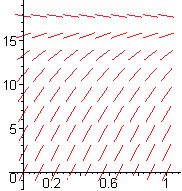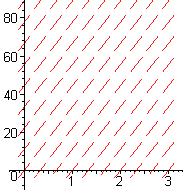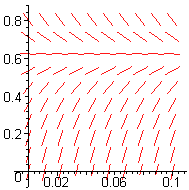Chapter 5
Modeling with Differential Equations
 5.1 Raindrops
5.1 Raindrops
- Figure E1 shows the slope fields for velocity, according to the Galileo, Stokes, and Velocity-Squared models, not necessarily in that order. Identify which is which.
 |
 |
 |
| Slope Field A | Slope Field B | Slope Field C |
- The Galileo Model is represented by Slope Field _____.
- The Stokes Model is represented by Slope Field _____.
- The Velocity Squared Model is represented by Slope Field _____.
-
 Recall that a marble dropped from a height of \(535\) feet, according to Galileo's Model (no air resistance), would hit the ground at \(127\) miles per hour. We also computed that a raindrop falling from \(3000\) feet — if it were a marble — would hit the ground at about \(300\) MPH.
Recall that a marble dropped from a height of \(535\) feet, according to Galileo's Model (no air resistance), would hit the ground at \(127\) miles per hour. We also computed that a raindrop falling from \(3000\) feet — if it were a marble — would hit the ground at about \(300\) MPH.
- Find a formula for the time of fall, according to Galileo's Model, from an arbitrary height \(h\).
- Find a formula for the speed at impact in miles per hour. (Be careful with units.)
You can use the two cases calculated already to check your formula.
- Use your formula to find the speed at impact for a fall from \(10\) feet; \(100\) feet; \(1000\) feet; \(10,000\) feet.
- You have determined the following basic facts for a falling object whose drag (air resistance) is proportional to velocity with proportionality constant \(k\): The terminal velocity \(v\)term is \(\frac{g}{k}\), and the velocity at time \(t\) is
- Find a formula for the time to reach 99% of terminal velocity, in terms of \(k\).
- What would \(k\) have to be in order to take one hour to reach 99% of terminal velocity?
- Suppose resistance is proportional to \(\sqrt{v}\), as might be the case for a small object falling through a viscous fluid. Find an expression for the terminal velocity in terms of \(g\) and the proportionality constant \(k\).
-
 Pilots and parachutists know (and physicists confirm) that the Velocity-Squared Model applies to the resisting force of air on an airplane wing or a falling human body, with or without a parachute. Thus, the acceleration equation has the form \(\frac{dv}{dt}=g-c v^2\).
Ms. Jennifer Phillips of Orange, MA, an experienced sky diver, reports the following free fall terminal velocities:
Pilots and parachutists know (and physicists confirm) that the Velocity-Squared Model applies to the resisting force of air on an airplane wing or a falling human body, with or without a parachute. Thus, the acceleration equation has the form \(\frac{dv}{dt}=g-c v^2\).
Ms. Jennifer Phillips of Orange, MA, an experienced sky diver, reports the following free fall terminal velocities:
- \(170\) mph in fetal position,
- \(140\) mph in a nose dive,
- \(120\) mph in a horizontal position with arms and legs spread out.
\(v(t)=v\)term\(\left(1-e^{-kt}\right)\).
You may check your formula with the case you already know, the drizzle drop for which \(k=\frac{0.329}{D^2} \times 10^{-5} \text{sec}^{-1}\) and \(D=0.00025\) feet.
![]() Note 2 – Sources
Note 2 – Sources

